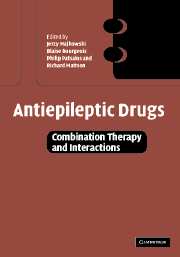Book contents
- Frontmatter
- Contents
- List of contributors
- Foreword
- Foreword
- Acknowledgements
- Part I Introduction
- Part II Pharmacokinetic interactions
- 4 Pharmacokinetic principles and mechanisms of drug interactions
- 5 Predictability of metabolic antiepileptic drug interactions
- 6 Influence of food and drugs on the bioavailability of antiepileptic drugs
- 7 Interactions between antiepileptic drugs
- 8 Interactions between antiepileptic and non-antiepileptic drugs
- Part III Pharmacodynamic interactions
- Part IV Drug interactions in specific patient populations and special conditions
- Part V Conclusions and future perspectives
- Index
8 - Interactions between antiepileptic and non-antiepileptic drugs
from Part II - Pharmacokinetic interactions
Published online by Cambridge University Press: 07 September 2009
- Frontmatter
- Contents
- List of contributors
- Foreword
- Foreword
- Acknowledgements
- Part I Introduction
- Part II Pharmacokinetic interactions
- 4 Pharmacokinetic principles and mechanisms of drug interactions
- 5 Predictability of metabolic antiepileptic drug interactions
- 6 Influence of food and drugs on the bioavailability of antiepileptic drugs
- 7 Interactions between antiepileptic drugs
- 8 Interactions between antiepileptic and non-antiepileptic drugs
- Part III Pharmacodynamic interactions
- Part IV Drug interactions in specific patient populations and special conditions
- Part V Conclusions and future perspectives
- Index
Summary
Introduction
Clinically important drug interactions occur essentially at two levels – at the pharmacokinetic level and at the pharmacodynamic level (Patsalos et al., 2002; Patsalos and Perucca, 2003a). By far the most important interactions are pharmacokinetic in nature and this is partly due to the fact that they are particularly prevalent in relation to antiepileptic drug (AED) use and also because they are more readily detected and quantitated. Whilst pharmacodynamic interactions are also of clinical significance they are less well documented and indeed difficult to quantitate. Pharmacokinetic interactions are associated with a change in blood concentration as a consequence of alterations in absorption, protein binding, distribution, metabolism or elimination of a drug.
Since AEDs are frequently used for years, decades or even throughout a patient's life, it is inevitable that drugs for the treatment of concurrent diseases will be co-prescribed. In this setting the potential for interactions is high and there are many such interactions that have been described (Patsalos and Perucca, 2003b). By far the most important and clinically significant interactions occur either as the consequence of hepatic enzyme inhibition or hepatic enzyme induction of cytochrome P450 (CYP) isoenzymes. Enzyme induction results in reduction in blood concentrations and possibly a loss of an adequate therapeutic response whilst enzyme inhibition results in an elevation in blood concentrations and possibly toxicity.
Keywords
- Type
- Chapter
- Information
- Antiepileptic DrugsCombination Therapy and Interactions, pp. 139 - 178Publisher: Cambridge University PressPrint publication year: 2005
- 1
- Cited by



